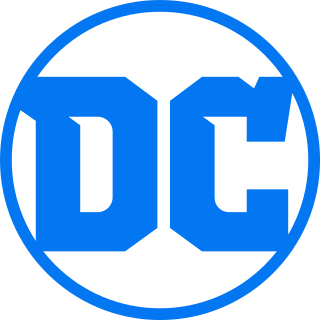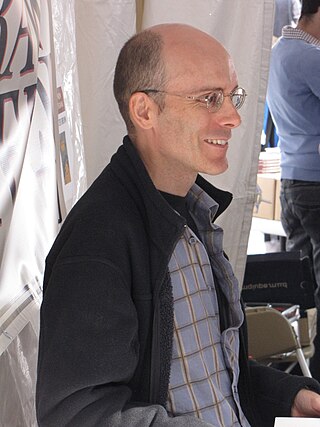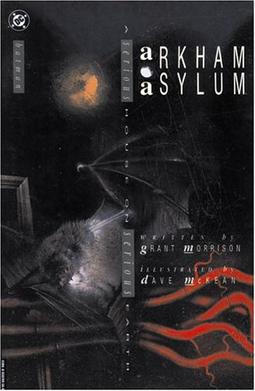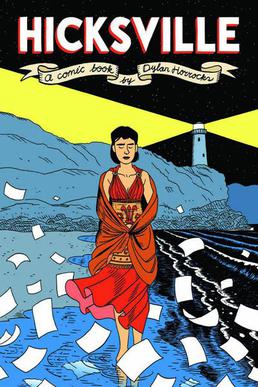Related Research Articles

A comic book, also called comicbook, comic magazine or simply comic, is a publication that consists of comics art in the form of sequential juxtaposed panels that represent individual scenes. Panels are often accompanied by descriptive prose and written narrative, usually, dialogue contained in word balloons emblematic of the comics art form.

DC Comics, Inc. is an American comic book publisher and the flagship unit of DC Entertainment, a subsidiary of Warner Bros. Discovery. DC is an initialism for "Detective Comics", an American comic book series first published in 1937.

Watchmen is a comic book limited series by the British creative team of writer Alan Moore, artist Dave Gibbons and colorist John Higgins. It was published monthly by DC Comics in 1986 and 1987 before being collected in a single-volume edition in 1987. Watchmen originated from a story proposal Moore submitted to DC featuring superhero characters that the company had acquired from Charlton Comics. As Moore's proposed story would have left many of the characters unusable for future stories, managing editor Dick Giordano convinced Moore to create original characters instead.
A graphic novel is a long-form work of sequential art. The term graphic novel is often applied broadly, including fiction, non-fiction, and anthologized work, though this practice is highly contested by comics scholars and industry professionals. It is, at least in the United States, typically distinct from the term comic book, which is generally used for comics periodicals and trade paperbacks.

Daniel Gillespie Clowes is an American cartoonist, graphic novelist, illustrator, and screenwriter. Most of Clowes's work first appeared in Eightball, a solo anthology comic book series. An Eightball issue typically contained several short pieces and a chapter of a longer narrative that was later collected and published as a graphic novel, such as Like a Velvet Glove Cast in Iron (1993), Ghost World (1997), David Boring (2000) and Patience (2016). Clowes's illustrations have appeared in The New Yorker, Newsweek, Vogue, The Village Voice, and elsewhere. With filmmaker Terry Zwigoff, Clowes adapted Ghost World into a 2001 film and another Eightball story into the 2006 film, Art School Confidential. Clowes's comics, graphic novels, and films have received numerous awards, including a Pen Award for Outstanding Work in Graphic Literature, over a dozen Harvey and Eisner Awards, and an Academy Award nomination.

An American comic book is a thin periodical originating in the United States, on average 32 pages, containing comics. While the form originated in 1933, American comic books first gained popularity after the 1938 publication of Action Comics, which included the debut of the superhero Superman. This was followed by a superhero boom that lasted until the end of World War II. After the war, while superheroes were marginalized, the comic book industry rapidly expanded and genres such as horror, crime, science fiction and romance became popular. The 1950s saw a gradual decline, due to a shift away from print media in the wake of television and the impact of the Comics Code Authority. The late 1950s and the 1960s saw a superhero revival and superheroes remained the dominant character archetype throughout the late 20th century into the 21st century.

Nelson Alexander Ross is an American comic book writer and artist known primarily for his painted interiors, covers, and design work. He first became known with the 1994 miniseries Marvels, on which he collaborated with writer Kurt Busiek for Marvel Comics. He has since done a variety of projects for both Marvel and DC Comics, such as the 1996 miniseries Kingdom Come, which he also cowrote. Since then he has done covers and character designs for Busiek's series Astro City, and various projects for Dynamite Entertainment. His feature film work includes concept and narrative art for Spider-Man (2002) and Spider-Man 2 (2004), and DVD packaging art for the M. Night Shyamalan film Unbreakable (2000). He has done covers for TV Guide, promotional artwork for the Academy Awards, posters and packaging design for video games, and his renditions of superheroes have been merchandised as action figures.

Jeff Smith is an American cartoonist. He is best known as the creator of the self-published comic book series Bone.
An autobiographical comic is an autobiography in the form of comic books or comic strips. The form first became popular in the underground comix movement and has since become more widespread. It is currently most popular in Canadian, American and French comics; all artists listed below are from the U.S. unless otherwise specified.

Chester William David Brown is a Canadian cartoonist. Brown has gone through several stylistic and thematic periods. He gained notice in alternative comics circles in the 1980s for the surreal, scatological Ed the Happy Clown serial. After bringing Ed to an abrupt end, he delved into confessional autobiographical comics in the early 1990s and was strongly associated with fellow Toronto-based cartoonists Joe Matt and Seth, and the autobiographical comics trend. Two graphic novels came from this period: The Playboy (1992) and I Never Liked You (1994). Surprise mainstream success in the 2000s came with Louis Riel (2003), a historical-biographical graphic novel about rebel Métis leader Louis Riel. Paying for It (2011) drew controversy as a polemic in support of decriminalizing prostitution, a theme he explored further with Mary Wept Over the Feet of Jesus (2016), a book of adaptations of stories from the Bible that Brown believes promote pro-prostitution attitudes among early Christians.

Drawn & Quarterly (D+Q) is a publishing company based in Montreal, Quebec, Canada, specializing in comics. It publishes primarily comic books, graphic novels and comic strip collections. The books it publishes are noted for their artistic content, as well as the quality of printing and design. The name of the company is a pun on "drawing", "quarterly", and the practice of hanging, drawing and quartering. Initially it specialized in underground and alternative comics, but has since expanded into classic reprints and translations of foreign works. Drawn & Quarterly was the company's flagship quarterly anthology during the 1990s.

It's a Good Life, If You Don't Weaken is a graphic novel by Canadian cartoonist Seth. It appeared in a collected volume in 1996 after serialization from 1993 to 1996 in issues #4–9 of Seth's comic book series Palookaville. The mock-autobiographical story tells of its author's obsessive search for the work of a fictional forgotten cartoonist.

The Power of Shazam! is a 1994 hardcover graphic novel, written and painted by Jerry Ordway for DC Comics. The 96-page story, depicting the revamped origins of former Fawcett Comics superhero Captain Marvel, was followed by an ongoing series, also titled The Power of Shazam!, which ran from 1995 to 1999.

Arkham Asylum: A Serious House on Serious Earth is a Batman graphic novel written by Grant Morrison and illustrated by Dave McKean. The story follows the vigilante Batman, who is called upon to quell a maddening riot taking place in the infamous Arkham Asylum, a psychiatric hospital housing the most dangerous supervillains in Gotham City. Inside, Batman confronts many of his enduring rogues gallery, such as the Joker, Two-Face, and Killer Croc. As Batman ventures deeper, he discovers the origin of how the asylum was established, the history of its founder Amadeus Arkham, and the supernatural and psychological mystery that has been haunting the mansion.

Jeffrey Brown is an American cartoonist born in Grand Rapids, Michigan.

Matt Kindt is an American comic book writer, cartoonist, and graphic designer. His early creator-owned works were spy fiction, and their success led to mainstream work for hire projects in superhero fiction and other genres. His work has been nominated for Eisner Awards and Harvey Awards. In the comic industry, he is best known for his work on MIND MGMT, the Valiant Entertainment superhero universe, and BRZRKR, the first issue of which is the highest-selling single comic issue of the 21st century.

Andy Mangels is an American science fiction author who has written novels, comic books, and magazine articles, and produced DVD collections, mostly focusing on media in popular culture. As an openly gay man, he has been a longtime advocate for greater visibility of gay and lesbian characters in various media, especially comics, including the coordination and moderation of the annual "Gays in Comics" panel for Comic Con International since it was begun in 1988. He is the founder of an annual "Women of Wonder Day" event, which raised over $136,000 in funds for domestic violence shelters and related programs during its seven-year run. As of 2011 he has had three books on the USA Today "best-selling books" list.

Hicksville is a graphic novel by Dylan Horrocks originally published by Black Eye Comics in 1998. The novel explores the machinations of the comic book industry, and contains a slightly fictionalized account of the history of mainstream American comics, with particular attention paid to the era of Image Comics.

"Superduperman" is a satirical story by Harvey Kurtzman and Wally Wood that was published in the fourth issue of Mad. Lampooning both Superman and Captain Marvel, it revolutionized the types of stories seen in Mad, leading to greatly improved sales. Writers such as Alan Moore have cited this story as an influence.
Canadian comics refers to comics and cartooning by citizens of Canada or permanent residents of Canada regardless of residence. Canada has two official languages, and distinct comics cultures have developed in English and French Canada. The English tends to follow American trends, and the French, Franco-Belgian ones, with little crossover between the two cultures. Canadian comics run the gamut of comics forms, including editorial cartooning, comic strips, comic books, graphic novels, and webcomics, and are published in newspapers, magazines, books, and online. They have received attention in international comics communities and have received support from the federal and provincial governments, including grants from the Canada Council for the Arts. There are comics publishers throughout the country, as well as large small press, self-publishing, and minicomics communities.
References
- ↑ Arnold, Andrew. "The Best Comix". Time. Archived from the original on 22 May 2011. Retrieved 31 October 2011.